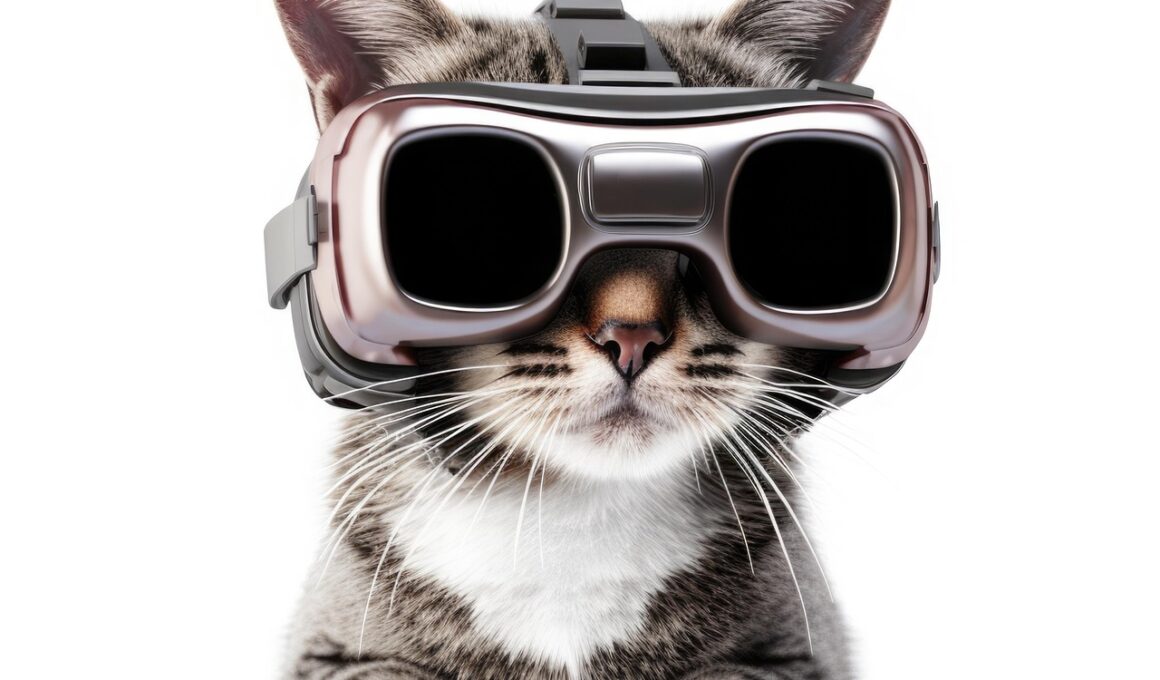Virtual Reality Applications in Cat Sports Training
Cat sports training has been greatly enhanced by the integration of virtual reality (VR) technology. This advancement not only engages the cats but also positively impacts their training performance. Traditional training methods, such as positive reinforcement, can be further supplemented with VR-based simulations. These simulations present an array of environments that allow cats to experience new challenges in a controlled setting. By replicating various conditions seen in competitive sports, VR creates a more stimulating training regimen, motivating the cats to perform better. For instance, using virtual environments can help acclimate a cat to the sights and sounds of a competition. This preparation reduces anxiety and increases confidence when transitioning to real-world events. Owners can track their pet’s progress, adjusting training programs in real time, based on performance outcomes. The feedback from these sessions empowers trainers to create personalized training plans, catering specifically to each cat’s unique strengths and weaknesses. Ultimately, VR technology holds the potential to revolutionize cat sports. It takes training to innovative heights, making it more effective in promoting physical and mental preparedness.
Moreover, the use of virtual reality offers an unparalleled level of engagement for both trainers and their feline companions. By immersing the cats in a virtual landscape, the training sessions become more interactive and enjoyable. This excitement encourages cats to participate actively, which is crucial for optimal learning. Trainers can introduce various scenarios that replicate real-world challenges, allowing cats to develop critical agility, speed, and coordination. For example, training on a simulated tightrope can prepare cats for competitions that require balance and precision. The immersive quality of VR can drastically reduce the likelihood of injuries during practice by providing controlled settings for potentially risky movements. In addition, virtual reality can simulate the presence of other competitors, enabling cats to get used to surrounding activity, mimicking an actual competition atmosphere. This not only helps with performance but also conditions cats mentally for high-pressure environments. Furthermore, as technology continues to advance, the graphics and scenarios built for VR training will become even more sophisticated, keeping the training process fresh and engaging. Thus, the future of cat sports training looks bright, with virtual reality paving the way for advancements in training techniques.
Benefits of VR in Cat Training
One significant advantage of incorporating virtual reality into cat sports training is the ability to track individual progress in real time. Utilizing VR technology, trainers can collect data during sessions, including speed, agility, and response times. These analytics provide valuable insights into a cat’s performance, allowing for precise adjustments to training routines. Moreover, this data-driven approach enables better identification of effective strategies that work for each cat. Additionally, trainers can implement a range of scenarios to keep training stimulating and challenging. For instance, a trainer may select a VR environment that simulates various terrains cats might encounter during competitions. This can include different types of surfaces, obstacles, and distractions. The ability to quickly switch between scenarios makes it possible to customize training sessions on the fly, maintaining the cat’s interest and focus. Furthermore, VR training can foster a closer bond between the trainer and the cat, as they work together in an exciting and imaginative environment. Ultimately, the benefits of VR transcend mere performance improvement. They augment the overall experience for the trainers and cats alike, transforming how we prepare for cat sports.
Another compelling reason for the adoption of virtual reality in cat sports is the enriched learning experience it offers. Standard training methods often rely on repetitive actions that can become monotonous over time. This monotony can lead to disengagement or even reluctance to train. Conversely, VR training keeps the training routines fresh and engaging, as the landscapes and challenges are ever-changing. This stimulation can encourage cats to stay motivated and focused, ultimately leading to better results. Additionally, trainers can utilize VR technology to visualize complex movements or techniques, bridging the gap between theory and practice. Demonstrating these techniques becomes interactive, addressing any confusion a cat may exhibit during real-world practice. This unique platform allows trainers to experiment with various techniques and observe how their cats respond, resulting in quicker learning. For those engaged in competitive sports, this immersive experience can lead to meaningful performance improvements. As both cats and trainers adapt to the technology, there is potential for developing new skills that were previously deemed challenging or tiring. Thus, the enrichment that virtual reality infuses into cat training proves invaluable in progressing individual training journeys.
Challenges in VR Implementation
Despite its many advantages, implementing virtual reality in cat sports training poses several challenges. First and foremost is the need for specialized equipment, which can be costly for many trainers and cat owners. The investment required may deter some potential users, limiting access to VR technology. Additionally, some cats may exhibit initial hesitation toward the VR gear, leading to a gradual acclimatization period. Trainers must exercise patience, ensuring the cats are comfortable during each training session. Another challenge involves creating realistic and engaging VR environments that mimic real-life scenarios fluently. Developers of VR content must possess a deep understanding of feline behavior to craft experiences that are practical and valuable for training. Furthermore, the complexity of integrating sensors and motion tracking technology complicates the design of effective VR training systems. These systems must function seamlessly to provide real-time feedback for both the trainers and the cats. Fortunately, advancements in technology are bringing innovative solutions to these challenges. Ongoing research and development within this field promise to simplify usability and enhance the overall user experience, helping cat trainers embrace VR technology.
Looking toward the future, it is evident that cat sports training is on the verge of transformation through virtual reality. As technology continues to advance, the application of VR will become increasingly widespread among cat trainers. Continuous improvements in VR hardware and software will enhance interfaces, making them user-friendly for cats and trainers alike. Furthermore, the growing interest in incorporating technology into animal training suggests that the pet industry will invest more resources into developing specialized programs. Such investments will enable the production of new, immersive training experiences catered specifically to various cat sports disciplines. The potential for collaboration between tech developers and animal behavior specialists could result in groundbreaking innovations, ensuring that VR applications remain relevant and effective. Enhanced training methods may lead to a new generation of highly trained cats, excelling in agility competitions, obstacle courses, and other sports. Ultimately, the adoption of virtual reality presents an exciting opportunity for the future of cat sports training. Trainers who are willing to explore and embrace this technology will reap significant rewards, ultimately shaping the future of feline athletics for years to come.
In summary, the integration of virtual reality technology in cat sports training is paving the way for innovative techniques that foster both performance and enjoyment. Through the combination of immersive experiences and real-time feedback, trainers are equipped with valuable tools to enhance their training programs effectively. The enriched learning environments provide both emotional and cognitive stimulation, making the overall experience enjoyable for cats. Furthermore, as trainers and technology developers collaborate to enhance VR experiences, it is likely that cat sports will become increasingly accessible and engaging. As this evolution occurs, trainers can expect to see significant improvements in performance metrics and overall training satisfaction. This forward-thinking approach could lead to a new standard in feline athletics, where technology and sports training coexist seamlessly. In conclusion, embracing virtual reality not only allows for enhanced training but also promotes a deeper bond between felines and their human companions. As both cats and trainers explore this dynamic new territory together, the future of cat sports training shines brightly, reflecting the potential of technology to transform lives.
In summary, the integration of virtual reality technology in cat sports training is paving the way for innovative techniques that foster both performance and enjoyment. Through the combination of immersive experiences and real-time feedback, trainers are equipped with valuable tools to enhance their training programs effectively. The enriched learning environments provide both emotional and cognitive stimulation, making the overall experience enjoyable for cats. Furthermore, as trainers and technology developers collaborate to enhance VR experiences, it is likely that cat sports will become increasingly accessible and engaging. As this evolution occurs, trainers can expect to see significant improvements in performance metrics and overall training satisfaction. This forward-thinking approach could lead to a new standard in feline athletics, where technology and sports training coexist seamlessly. In conclusion, embracing virtual reality not only allows for enhanced training but also promotes a deeper bond between felines and their human companions. As both cats and trainers explore this dynamic new territory together, the future of cat sports training shines brightly, reflecting the potential of technology to transform lives.


